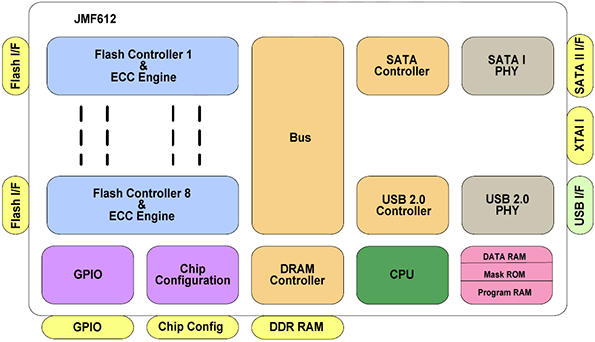7-Way SSD Round-Up: Sandforce vs. JMicron
Introductions and Controllers
It is hard to believe that almost two years has passed since we first rounded-up some of the first solid state drive offerings for the PC. Since that time, the landscape has changed dramatically. Capacities have increased somewhat, but performance has been improved significantly. Many early solid sate drives suffered from terrible stuttering issues and offered performance that was actually lower than much more affordable, traditional hard drives. Today though, SSDs are far more stable and reliable and their performance is orders-of-magnitude better than even the fastest of hard drives.
Despite the rapid pace of advancement in the SSD space, innovation doesn't seem to be slowing. With that in mind, we've pulled together a quintet of the newest drives to hit the market, based on recently released controller designs from SandForce and long-time player JMicron, the SF1200 and JM612, respectively. We've got drives from OCZ, OWC, Corsair, and Patriot Memory on tap, but before we dig into the products themselves, let's take some time to talk about the controllers at the heart of the drives. It is, after all, the SSD's controller that determines much of how a drive will behave and perform in the real-world...
Update 6/25/2010: Shortly after publishing this round-up, a number of SSD manufacturers that employ Sandforce controllers released updated drives that offered more usable capacity to end users. The first wave of SF-1200 based drives to hit the scene had about 22% of their flash memory over-provisioned for cache purposes, wear-leveling, and other proprietary Sandforce functions. 100GB drives like the OCZ Vertex 2 and Corsair Force 100, for example, actually featured 128GB of flash memory on-board. The second wave of drives to arrive, however, have about 6.25% of their flash memory over-provisioned, and as such, they offer more usable capacity to end users.
We received 120 GB variants of the OCZ Vertex 2 and Corsair Force drives, and have updated this round-up with their performance results. As you'll see, other than offering more capacity, not much has changed in terms of performance. What the less over-provisioning means to the longevity of the drives remains to be seen, but the new drives still offer the same warranty. Manufacturers are willing to stand behind them.
SandForce and JMicron Based Drives From OCZ, OWC, Patriot and Corsair -- One of These Drives Is Not Like the Others...
 Although it has a different model number, the SandForce SF1200 controller is actually based on the same piece of silicon as the higher-end SF1500, which first debuted in OCZ's Vertex 2 Pro. The SF1500 is targeted at enterprise-class products, and as such, it goes through more vigorous validation and testing. This inevitably leads to higher costs. The SF1200 is targeted at the desktop PC space, however, and isn't subjected to as vigorous a test routine. But as a result, SandForce also imposes some random read / write limits via tweaked firmware to minimize risk. Whereas the SF1500 can theoretically push upwards of 30,000 4K random-write IOPS, for example, the SD1200 is rated for only 1/3 of that. Other than the imposed performance limitation though, the SF1200 is virtually identical to the SF1500.
Although it has a different model number, the SandForce SF1200 controller is actually based on the same piece of silicon as the higher-end SF1500, which first debuted in OCZ's Vertex 2 Pro. The SF1500 is targeted at enterprise-class products, and as such, it goes through more vigorous validation and testing. This inevitably leads to higher costs. The SF1200 is targeted at the desktop PC space, however, and isn't subjected to as vigorous a test routine. But as a result, SandForce also imposes some random read / write limits via tweaked firmware to minimize risk. Whereas the SF1500 can theoretically push upwards of 30,000 4K random-write IOPS, for example, the SD1200 is rated for only 1/3 of that. Other than the imposed performance limitation though, the SF1200 is virtually identical to the SF1500.
Even though there's a supposed performance limiter imposed via firmware by SandForce on the SF1200, not every manufacture has implemented it. Of the drives we feature here, the OCZ Vertex 2 and Corsair Force Series F100 actually don't have the limiter in place. The Agility 2 and OWC drive do.

Above is a high-level block diagram of the SF1200, that may look familiar to some of you. It is the same diagram we first showed you in our coverage of the Vertex 2 Pro. Because we've already covered the main features of this controller in a previous article, we won't do the same here. But those of you seeking a more technical deep-dive into SandForce's controller offerings, should check out our Vertex 2 Pro article. We talk about the SandForce controller's DuraWrite, RAISE, and other features there.

Above is a high-level block diagram of the JMicron JMF612. The JMicron JMF612 is a single-chip, 8-channel NAND flash controller with a SATA II and USB 2.0 combo interface. The JMF612 supports external SDRAM cache and also offers support for hardware error correction code (ECC), wear leveling, and bad block management technology. And unlike JMicron's much maligned early SSD controllers though, the HMF612's firmware is field upgradeable via a simple utility. The JMF612 sports an embedded processor, internal masked ROM, data SRAM, a SATA link/transport layer, SATA PHY, USB 2.0 device controller and USB 2.0 PHY. And the chip itself is available in a 281-pin BGA (12mm x12 mm) package.
Of all of the drives represented here, the Patriot Zephyr is the only one to be built around the JMicron JMF612 controller.






